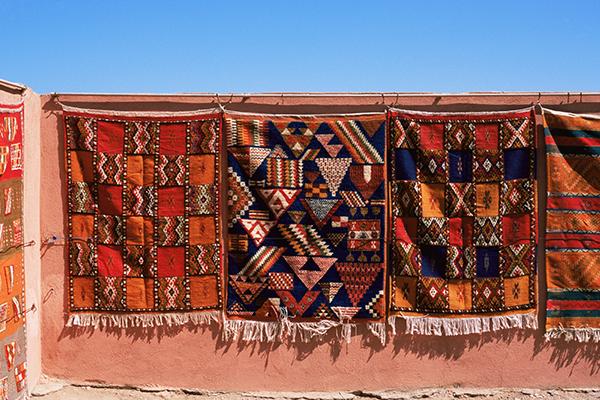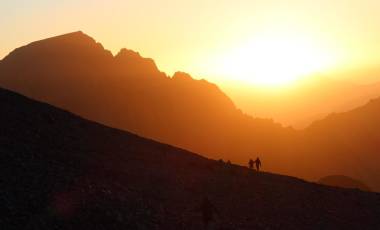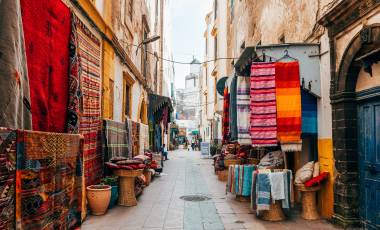Welcome to one of the most animated places on the planet – the ancient medina in Marrakech. Situated at the base of the Atlas Mountains, Marrakech has been sitting on important trading routes since the 11th century with African merchants travelling far and wide to sell their goods – and not much has changed since.
Inside the powder-pink ramparts of the ancient medina, you’ll find everything from billowing silk scarves, brass lamps, intricate Berber rugs and barrels of vibrantly colored spices. Once you make your way around this labyrinth of ochre-dusted lanes, you’ll find the vast square of Djemaa El Fna. Coming alive with local musicians, snake charmers and acrobats every night when the sun sets, this famously heady square is the perfect place to pick up interesting North African flavors and spices or a traditional boucherouite rug for your living room.
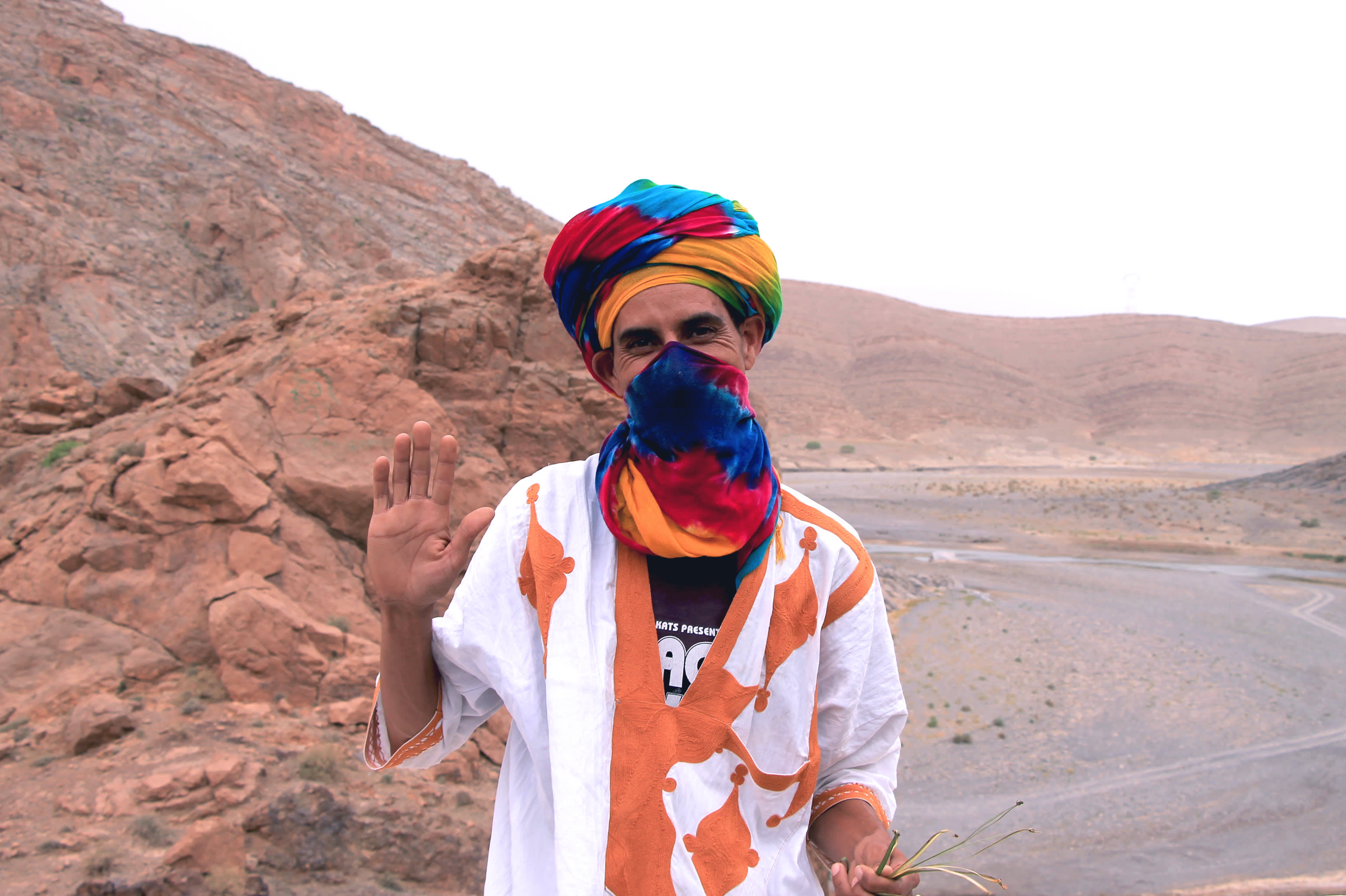
Our local leader in Morocco, Mustapha Bentaleb, knows the souks of Marrakech like the back of his hand. He is here to help you navigate your way through the main market streets of Souq Semmarine and Souq El Kebir, while also sharing key insights into the art of haggling and making authentic purchases. He explains, “While walking around Morocco’s Red City, it is so easy to get lost and confused about what to buy. We understand this is no easy task, so we’ve provided useful tips and a list of 7 key things you should buy while exploring this wonderful city”.
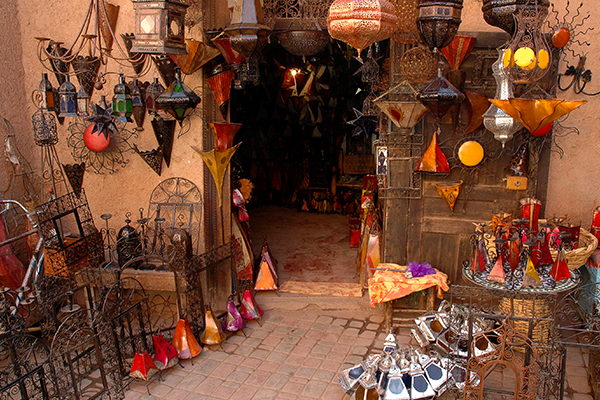
1. Lanterns
“The first thing you’ll notice in Marrakech, especially in Jemaa al-Fnaa at night is all the fantastic array of beautiful lanterns. There are specific shops which provide different classic geometric styles, sizes and qualities inside the bustling medina” Mustapha says. Hand-crafted artisan Moroccan lanterns and lamp salesmen can easily be found among the street shops that line the edges of the central square.
Moroccan lanterns are one of the most aesthetically pleasing pieces of decoration to light up any space in your home. Elegant glass mosaic table lamps and lanterns have been home staples for locals throughout Morocco and the Ottoman Empire for centuries and is a great trinket you’ll enjoy for years after your trip.

2. Colorful Slippers
Point-toed traditional Moroccan leather babouches (slippers) are a great souvenir of a time-well spent in Morocco. They’ve been all the rage for centuries and if you’re lucky in finding an authentic pair, you’ll see that the babouche sellers use age-old, traditional techniques to create these comfy, vibrant slippers.
Coming in a variety of colours and styles, the thick-soled slippers are often worn by local Marrakchis both in Djemaa El Fna and in the new town, while the thin-soled slippers are designed for indoor wear only. Mustapha explains, “In Morocco, we like to wear our favourite babouches for special ceremonies, weddings or during religious days, but personally I love to wear mine around the house.” It’s good to remember that haggling and negotiating prices is common practice in the heady Marrakesh souks. Mustapha continues, “When you’ve found your colour, always haggle the price down.” After tackling North Africa’s highest mountain on our Mt Toubkal Climb trip, slipping into these leather-soled slippers for the evening, will be nothing short of perfection.
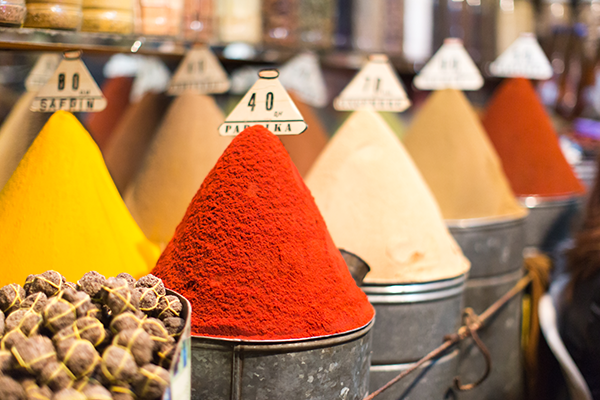
3. Spices
On our Highlights of Morocco trip, you will get the opportunity to visit the imperial cities of Rabat, Meknes, Fez while also spending two days in Morocco’s Red City – Marrakech. And while you’re here, you’ll undoubtedly experience an unforgettable array of aromas, whether it’s wafting from the souks in Jemaa el Fnaa Square, local restaurants or bustling food stalls down the labyrinth of alleyways in the ancient medina. So, why not take some of these delicious local spices home with you to recreate some of your favourite traditional dishes at home?
Mustapha recommends, “If you are unsure about what to buy, go for the speciality called “Ras El Hanout”, which means, “Head of the shop”, where you get over 30 mixed spices to take home”. And you can find Ras El Hanout just about anywhere that sells brilliant coloured spices, petals and leaves.
Each spice shop and stall make their own particular blend using only the best “Head of the shop” spices that are traditionally handed down from father to son and can have as many as 35 different spices in them. Although commonly, you can expect your Ras El Hanout to include paprika, cumin, cardamom, clove, cinnamon, coriander, nutmeg, aniseed, dried ginger, peppercorn and turmeric, with whole spices, dried roots and leaves all ground together. If you’re looking for the best quality spices, we’d recommend visiting Rahba Kedima, the apothecaries square in Marrakech, which is surrounded with multi-coloured spice stalls, or Apothicaire Tuareg, where you’ll find day to day spices and natural remedies at great prices.
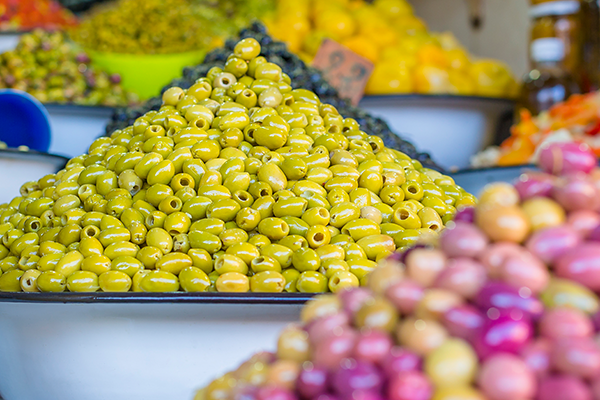
4. Olives
Mustapha explains that “Marrakech is located not far from the valleys of the High Atlas Mountains that are peppered full of ancient Olive trees, so you’re bound to get some great, fresh olives being sold all across the medina”. The rich valleys like Saraana valley, just outside the city of Marrakech are famous for their fine olives and high-quality oil. When the harvest takes place during the months of November and December, you’ll find the juiciest of olives in the souks.
Mustapha comments, “You’ll be amazed by the different olive colours in the medina, ranging from spicy to salty.” In the Jemaa el Fna Market on the east side of the square, there are seemingly endless amounts of green olives, matured black olives (which are the city’s speciality), pink olives, and even harissa marinated olives. Pair them with local pickles and preserved lemons for a great mid-day snack during the hot summers. On our Highlights of Morocco trip, we will enjoy a spectacular walk through Tigzha valley and visit a traditional village Hammam. Afterwards, we will enjoy a dinner, with local olives picked from the High Atlas Mountains.
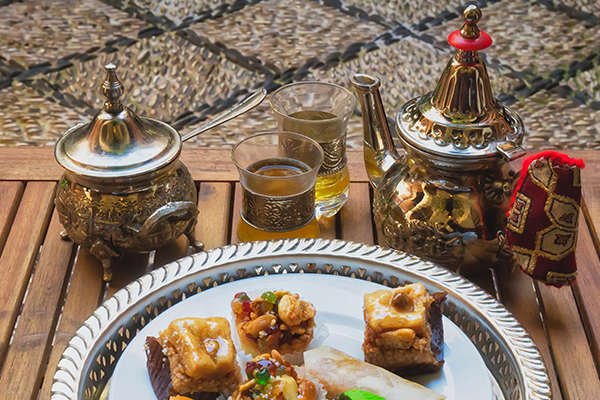
5. Teapots
One of the most cherished memories you’re bound to have in Morocco is finding an enchanting little Riad that serves traditional Moroccan tea and pastries. So, why not recreate that experience at home with your own oriental Moroccan teapot, that’s specially made to create the unique taste of an authentic Moroccan mint tea?
A good Moroccan teapot should be heat-resistant, as it will be in direct contact with your stove or electric plate for at least 2 minutes. If you’re considering buying a teapot in the bustling medina in Marrakech, you should make sure it can handle very high temperatures. Some are sold purely for decorative purposes, so we’d recommend that you avoid ceramic or clay teapots as they may crack under prolonged heat. If you’re looking to make authentic Moroccan tea for your guests at home, why not complete the set by buying Moroccan tea glasses. Coming in all colours and intricate designs, the locals love mixing different glass colors in the same set. These would be a great addition to your dining room back home!
6. Rugs
Mustapha explains, “Due to its central location and important historical commercial centre, the city of Marrakech has a big market for selling carpets that are either made in the surrounding regions or transported from the south of Morocco”. From beautiful handmade Berber boucherouite rugs to flat-weaved kilims and hand-knotted carpets, the stunning variety of rugs in Marrakech will make you feel like you’ve just entered a scene from Aladdin, but beware, the quality, design and price varies wildly in the souks. Mustapha comments, “Make sure you always bargain as the starting prices can be expensive”.
If you’re looking to casually browse carpets, we’d recommend heading to Ben Rahal where you’ll find two floors that are stacked to the ceiling with handiras (woollen wedding blankets from the Atlas Mountains), intricate shaggy Beni Ourain rugs and hand-woven kilims in every colour you can imagine. Creiee Berbere and the carpet souk just off Rahba Lakdima, Souk des Tapis, is also worth checking out for the atmosphere alone.
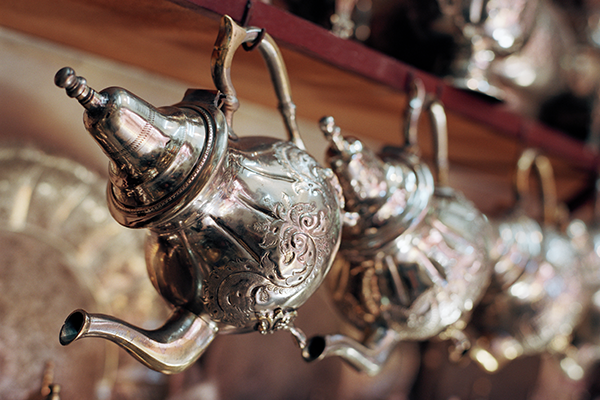
7. Silver trinkets
Many hundreds of years of history are preserved among the sparkling silver souks in Marrakech. Mustapha comments, “If you are not going to visit the south or west of Marrakech including the cities of Essaouira or Tiznit, Marrakech is still a great spot to find some quality silver items close to the Jewish quarter or behind the famous Argana restaurant”. The most striking silver is said to be made by the Berbers in the High Atlas Mountains and the Touregs, a tribe of desert nomads.
Once you look past the stalls selling incense, crystalised perfume and fresh Moroccan mint, you’ll find that “The Mellah”, the Old Jewish Quarter in Marrakech is home to a myriad of beautiful antique shops selling real silver jewellery, many of which have Jewish engravings on them. If you’d like to see the silver markets in the old walled town of Tiznit, we visit them on day 5 of our Atlas Descent trip after an exhilarating descent from the Tizi Mlil Pass.
If you’d like to experience the heady Marrakech Medina for yourself and pick up some beautiful mementoes, find out more about our adventure holidays in Morocco here.

